Buzhen Huang
E-React: Towards Emotionally Controlled Synthesis of Human Reactions
Aug 08, 2025Abstract:Emotion serves as an essential component in daily human interactions. Existing human motion generation frameworks do not consider the impact of emotions, which reduces naturalness and limits their application in interactive tasks, such as human reaction synthesis. In this work, we introduce a novel task: generating diverse reaction motions in response to different emotional cues. However, learning emotion representation from limited motion data and incorporating it into a motion generation framework remains a challenging problem. To address the above obstacles, we introduce a semi-supervised emotion prior in an actor-reactor diffusion model to facilitate emotion-driven reaction synthesis. Specifically, based on the observation that motion clips within a short sequence tend to share the same emotion, we first devise a semi-supervised learning framework to train an emotion prior. With this prior, we further train an actor-reactor diffusion model to generate reactions by considering both spatial interaction and emotional response. Finally, given a motion sequence of an actor, our approach can generate realistic reactions under various emotional conditions. Experimental results demonstrate that our model outperforms existing reaction generation methods. The code and data will be made publicly available at https://ereact.github.io/
Reconstructing Close Human Interaction with Appearance and Proxemics Reasoning
Jul 03, 2025Abstract:Due to visual ambiguities and inter-person occlusions, existing human pose estimation methods cannot recover plausible close interactions from in-the-wild videos. Even state-of-the-art large foundation models~(\eg, SAM) cannot accurately distinguish human semantics in such challenging scenarios. In this work, we find that human appearance can provide a straightforward cue to address these obstacles. Based on this observation, we propose a dual-branch optimization framework to reconstruct accurate interactive motions with plausible body contacts constrained by human appearances, social proxemics, and physical laws. Specifically, we first train a diffusion model to learn the human proxemic behavior and pose prior knowledge. The trained network and two optimizable tensors are then incorporated into a dual-branch optimization framework to reconstruct human motions and appearances. Several constraints based on 3D Gaussians, 2D keypoints, and mesh penetrations are also designed to assist the optimization. With the proxemics prior and diverse constraints, our method is capable of estimating accurate interactions from in-the-wild videos captured in complex environments. We further build a dataset with pseudo ground-truth interaction annotations, which may promote future research on pose estimation and human behavior understanding. Experimental results on several benchmarks demonstrate that our method outperforms existing approaches. The code and data are available at https://www.buzhenhuang.com/works/CloseApp.html.
TokenHSI: Unified Synthesis of Physical Human-Scene Interactions through Task Tokenization
Mar 25, 2025Abstract:Synthesizing diverse and physically plausible Human-Scene Interactions (HSI) is pivotal for both computer animation and embodied AI. Despite encouraging progress, current methods mainly focus on developing separate controllers, each specialized for a specific interaction task. This significantly hinders the ability to tackle a wide variety of challenging HSI tasks that require the integration of multiple skills, e.g., sitting down while carrying an object. To address this issue, we present TokenHSI, a single, unified transformer-based policy capable of multi-skill unification and flexible adaptation. The key insight is to model the humanoid proprioception as a separate shared token and combine it with distinct task tokens via a masking mechanism. Such a unified policy enables effective knowledge sharing across skills, thereby facilitating the multi-task training. Moreover, our policy architecture supports variable length inputs, enabling flexible adaptation of learned skills to new scenarios. By training additional task tokenizers, we can not only modify the geometries of interaction targets but also coordinate multiple skills to address complex tasks. The experiments demonstrate that our approach can significantly improve versatility, adaptability, and extensibility in various HSI tasks. Website: https://liangpan99.github.io/TokenHSI/
Adapting Human Mesh Recovery with Vision-Language Feedback
Feb 06, 2025



Abstract:Human mesh recovery can be approached using either regression-based or optimization-based methods. Regression models achieve high pose accuracy but struggle with model-to-image alignment due to the lack of explicit 2D-3D correspondences. In contrast, optimization-based methods align 3D models to 2D observations but are prone to local minima and depth ambiguity. In this work, we leverage large vision-language models (VLMs) to generate interactive body part descriptions, which serve as implicit constraints to enhance 3D perception and limit the optimization space. Specifically, we formulate monocular human mesh recovery as a distribution adaptation task by integrating both 2D observations and language descriptions. To bridge the gap between text and 3D pose signals, we first train a text encoder and a pose VQ-VAE, aligning texts to body poses in a shared latent space using contrastive learning. Subsequently, we employ a diffusion-based framework to refine the initial parameters guided by gradients derived from both 2D observations and text descriptions. Finally, the model can produce poses with accurate 3D perception and image consistency. Experimental results on multiple benchmarks validate its effectiveness. The code will be made publicly available.
Simultaneously Recovering Multi-Person Meshes and Multi-View Cameras with Human Semantics
Dec 25, 2024Abstract:Dynamic multi-person mesh recovery has broad applications in sports broadcasting, virtual reality, and video games. However, current multi-view frameworks rely on a time-consuming camera calibration procedure. In this work, we focus on multi-person motion capture with uncalibrated cameras, which mainly faces two challenges: one is that inter-person interactions and occlusions introduce inherent ambiguities for both camera calibration and motion capture; the other is that a lack of dense correspondences can be used to constrain sparse camera geometries in a dynamic multi-person scene. Our key idea is to incorporate motion prior knowledge to simultaneously estimate camera parameters and human meshes from noisy human semantics. We first utilize human information from 2D images to initialize intrinsic and extrinsic parameters. Thus, the approach does not rely on any other calibration tools or background features. Then, a pose-geometry consistency is introduced to associate the detected humans from different views. Finally, a latent motion prior is proposed to refine the camera parameters and human motions. Experimental results show that accurate camera parameters and human motions can be obtained through a one-step reconstruction. The code are publicly available at~\url{https://github.com/boycehbz/DMMR}.
Generalizable Human Gaussians from Single-View Image
Jun 10, 2024Abstract:In this work, we tackle the task of learning generalizable 3D human Gaussians from a single image. The main challenge for this task is to recover detailed geometry and appearance, especially for the unobserved regions. To this end, we propose single-view generalizable Human Gaussian model (HGM), a diffusion-guided framework for 3D human modeling from a single image. We design a diffusion-based coarse-to-fine pipeline, where the diffusion model is adapted to refine novel-view images rendered from a coarse human Gaussian model. The refined images are then used together with the input image to learn a refined human Gaussian model. Although effective in hallucinating the unobserved views, the approach may generate unrealistic human pose and shapes due to the lack of supervision. We circumvent this problem by further encoding the geometric priors from SMPL model. Specifically, we propagate geometric features from SMPL volume to the predicted Gaussians via sparse convolution and attention mechanism. We validate our approach on publicly available datasets and demonstrate that it significantly surpasses state-of-the-art methods in terms of PSNR and SSIM. Additionally, our method exhibits strong generalization for in-the-wild images.
Closely Interactive Human Reconstruction with Proxemics and Physics-Guided Adaption
Apr 17, 2024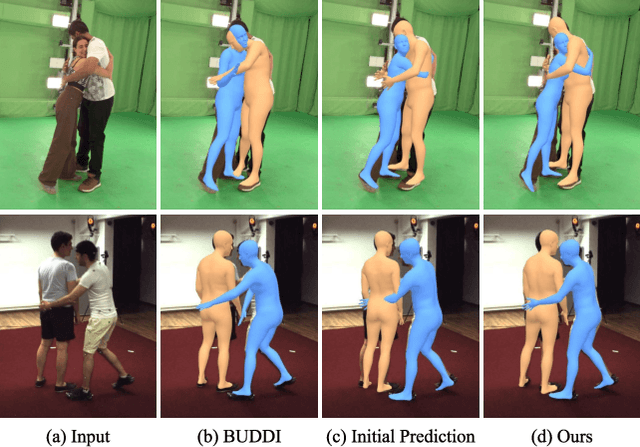
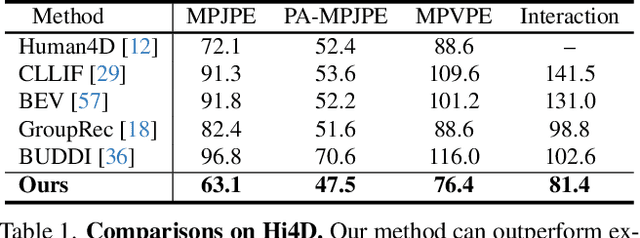
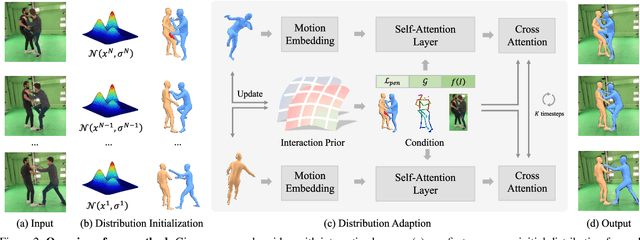

Abstract:Existing multi-person human reconstruction approaches mainly focus on recovering accurate poses or avoiding penetration, but overlook the modeling of close interactions. In this work, we tackle the task of reconstructing closely interactive humans from a monocular video. The main challenge of this task comes from insufficient visual information caused by depth ambiguity and severe inter-person occlusion. In view of this, we propose to leverage knowledge from proxemic behavior and physics to compensate the lack of visual information. This is based on the observation that human interaction has specific patterns following the social proxemics. Specifically, we first design a latent representation based on Vector Quantised-Variational AutoEncoder (VQ-VAE) to model human interaction. A proxemics and physics guided diffusion model is then introduced to denoise the initial distribution. We design the diffusion model as dual branch with each branch representing one individual such that the interaction can be modeled via cross attention. With the learned priors of VQ-VAE and physical constraint as the additional information, our proposed approach is capable of estimating accurate poses that are also proxemics and physics plausible. Experimental results on Hi4D, 3DPW, and CHI3D demonstrate that our method outperforms existing approaches. The code is available at \url{https://github.com/boycehbz/HumanInteraction}.
CrowdRec: 3D Crowd Reconstruction from Single Color Images
Oct 10, 2023Abstract:This is a technical report for the GigaCrowd challenge. Reconstructing 3D crowds from monocular images is a challenging problem due to mutual occlusions, server depth ambiguity, and complex spatial distribution. Since no large-scale 3D crowd dataset can be used to train a robust model, the current multi-person mesh recovery methods can hardly achieve satisfactory performance in crowded scenes. In this paper, we exploit the crowd features and propose a crowd-constrained optimization to improve the common single-person method on crowd images. To avoid scale variations, we first detect human bounding-boxes and 2D poses from the original images with off-the-shelf detectors. Then, we train a single-person mesh recovery network using existing in-the-wild image datasets. To promote a more reasonable spatial distribution, we further propose a crowd constraint to refine the single-person network parameters. With the optimization, we can obtain accurate body poses and shapes with reasonable absolute positions from a large-scale crowd image using a single-person backbone. The code will be publicly available at~\url{https://github.com/boycehbz/CrowdRec}.
Reconstructing Groups of People with Hypergraph Relational Reasoning
Aug 30, 2023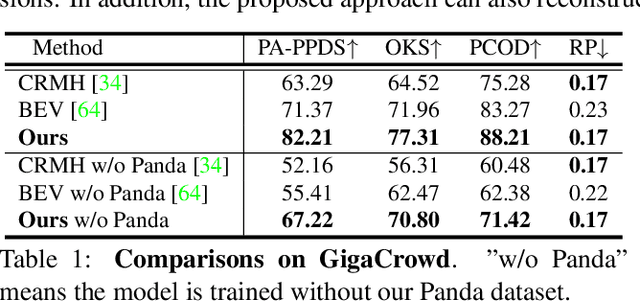

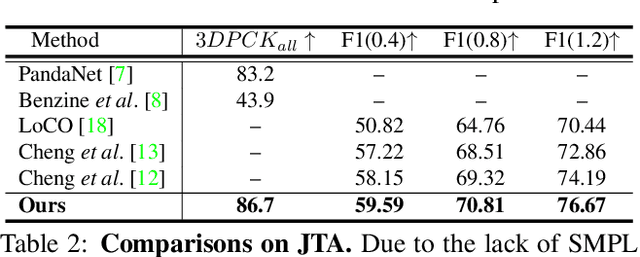

Abstract:Due to the mutual occlusion, severe scale variation, and complex spatial distribution, the current multi-person mesh recovery methods cannot produce accurate absolute body poses and shapes in large-scale crowded scenes. To address the obstacles, we fully exploit crowd features for reconstructing groups of people from a monocular image. A novel hypergraph relational reasoning network is proposed to formulate the complex and high-order relation correlations among individuals and groups in the crowd. We first extract compact human features and location information from the original high-resolution image. By conducting the relational reasoning on the extracted individual features, the underlying crowd collectiveness and interaction relationship can provide additional group information for the reconstruction. Finally, the updated individual features and the localization information are used to regress human meshes in camera coordinates. To facilitate the network training, we further build pseudo ground-truth on two crowd datasets, which may also promote future research on pose estimation and human behavior understanding in crowded scenes. The experimental results show that our approach outperforms other baseline methods both in crowded and common scenarios. The code and datasets are publicly available at https://github.com/boycehbz/GroupRec.
Physics-Guided Human Motion Capture with Pose Probability Modeling
Aug 19, 2023Abstract:Incorporating physics in human motion capture to avoid artifacts like floating, foot sliding, and ground penetration is a promising direction. Existing solutions always adopt kinematic results as reference motions, and the physics is treated as a post-processing module. However, due to the depth ambiguity, monocular motion capture inevitably suffers from noises, and the noisy reference often leads to failure for physics-based tracking. To address the obstacles, our key-idea is to employ physics as denoising guidance in the reverse diffusion process to reconstruct physically plausible human motion from a modeled pose probability distribution. Specifically, we first train a latent gaussian model that encodes the uncertainty of 2D-to-3D lifting to facilitate reverse diffusion. Then, a physics module is constructed to track the motion sampled from the distribution. The discrepancies between the tracked motion and image observation are used to provide explicit guidance for the reverse diffusion model to refine the motion. With several iterations, the physics-based tracking and kinematic denoising promote each other to generate a physically plausible human motion. Experimental results show that our method outperforms previous physics-based methods in both joint accuracy and success rate. More information can be found at \url{https://github.com/Me-Ditto/Physics-Guided-Mocap}.
 Add to Chrome
Add to Chrome Add to Firefox
Add to Firefox Add to Edge
Add to Edge